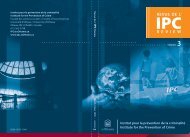Development of an outcome monitoring system for crisis telephone ...
Development of an outcome monitoring system for crisis telephone ...
Development of an outcome monitoring system for crisis telephone ...
You also want an ePaper? Increase the reach of your titles
YUMPU automatically turns print PDFs into web optimized ePapers that Google loves.
<strong>Development</strong> <strong>of</strong> <strong>an</strong> Outcome Monitoring System<br />
23<br />
needed. Similarly, two <strong>of</strong> the three respondents said that TAO had met most or almost all <strong>of</strong><br />
their needs.<br />
In response to <strong>an</strong> open-ended question about what they liked most about TAO<br />
<strong>telephone</strong> services, two respondents identified characteristics <strong>of</strong> volunteers that included<br />
helpfulness, warmth, patience, sensitivity, <strong>an</strong>d calmness. The other respondent referred to<br />
the assist<strong>an</strong>ce he or she has received.<br />
A question asking respondents to make suggestions <strong>for</strong> improving TAO services<br />
yielded only a response from one respondent. In particular, the respondent suggested that the<br />
agency needed <strong>an</strong> <strong>an</strong>swering machine. The respondent also mentioned that he disliked when<br />
he or she was asked to phone back because a current call was more import<strong>an</strong>t th<strong>an</strong> his or<br />
hers.<br />
Distress Centre <strong>of</strong> Ottawa <strong>an</strong>d Region<br />
Sample<br />
A total <strong>of</strong> 373 callers were rated by 15 volunteers at DCO over the course <strong>of</strong> the third<br />
pilot study. Women represented over two-thirds <strong>of</strong> the rated callers (72%) while men made a<br />
little over one-quarter <strong>of</strong> the rated callers (28%). The general content <strong>of</strong> the calls as assessed<br />
by volunteers showed the majority identified as involving distress (62%), followed by <strong>crisis</strong><br />
(23%) <strong>an</strong>d support (15%). As shown in Figure 3, there are similar proportions <strong>for</strong> the three<br />
type <strong>of</strong> callers who were rated in third pilot study with 39% identified by volunteers as<br />
occasional callers, 32% perceived to be new callers, <strong>an</strong>d 29% defined as repeat callers.<br />
Figure 3<br />
Type <strong>of</strong> Caller Rated at DCO (N = 373)<br />
29%<br />
39%<br />
Occasional<br />
New<br />
Repeat<br />
32%<br />
Interpersonal problems (82%) were the most frequent problem area identified by<br />
volunteers in the rated calls followed by mental health difficulties (76%). Other problems<br />
areas identified in rated calls by volunteers in descending order <strong>of</strong> frequency were physical<br />
health problems (33%), subst<strong>an</strong>ce abuse difficulties (24%), experience <strong>of</strong> abuse <strong>an</strong>d/or<br />
violence in relationships (18%), occupational <strong>an</strong>d/or fin<strong>an</strong>cial difficulties (18%), <strong>an</strong>d suicidal<br />
risk (18%). Of those 18% <strong>of</strong> callers identified as having a suicide risk, 14% were considered<br />
<strong>of</strong> low risk <strong>an</strong>d 4% were rated as being <strong>of</strong> a moderate to high risk.<br />
Centre <strong>for</strong> Research on Community Services
















